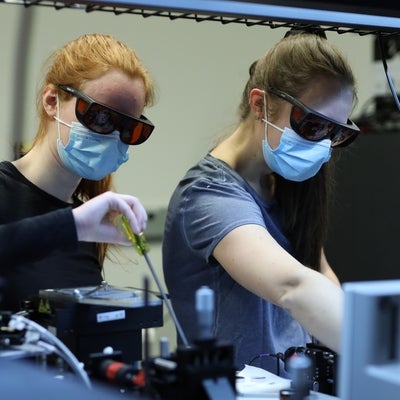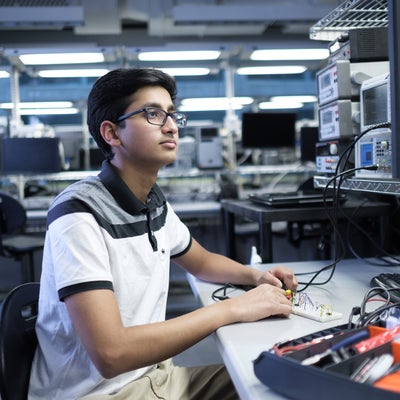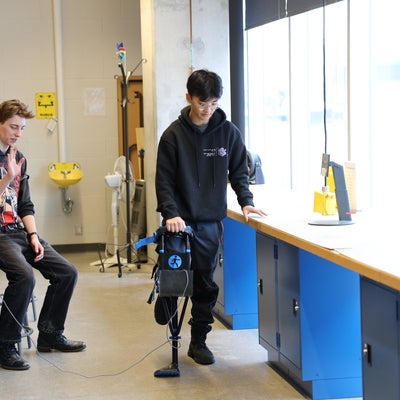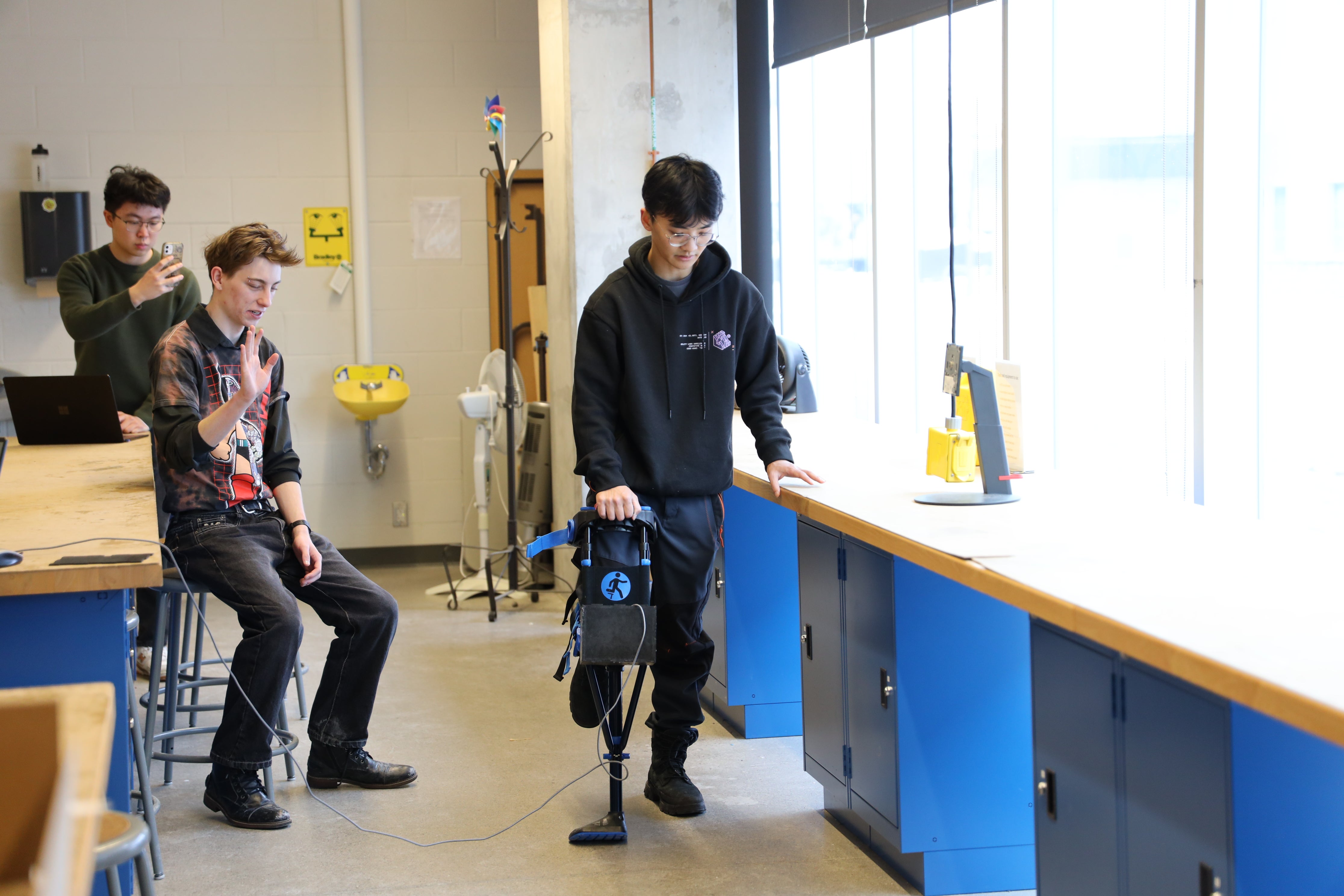Why Biomedical Engineering?
Close the gap between engineering and medicine. This program integrates principles of engineering with the biological sciences to develop better ways to diagnose illnesses, treat health problems and enhance health. It is is designed to equip students with the skills and knowledge necessary to develop innovative technologies and solutions for the healthcare industry, improving patient care and advancing medical research.
In our Biomedical Engineering program, you'll develop knowledge in engineering fundamentals, biomechanics, physics, physiology and design. Hands-on labs will give you experience modelling, prototyping and testing biomedical systems. By graduation, you'll be ready to design and build tomorrow's innovative healthcare technologies - from bionic limbs and implantable biomaterials to laser-guided surgical devices and wearable tech.
Courses in Biomedical Engineering
In your first year, you'll take foundational courses combining biology with applied sciences and engineering. You will begin to think about how to best approach solving health-related problems and gain the science and math skills to develop tools for medical diagnosis, treatment, and prevention. Utilizing engineering solutions, you will design innovative technologies – from new diabetic monitoring and cancer-imaging systems to the design of rehabilitation equipment.
Sample first-year courses
This is a sample schedule. Courses are subject to change.
| Fall Term (September to December) | Winter Term (January to April) |
|---|---|
Upper year courses
For information about courses past your first year, check out the Undergraduate Academic Calendar.
Customize your degree with options and specializations
Options
Options are a way to provide you with a path to expand your degree and get a secondary emphasis in another subject or area. They are available to any student within the Faculty of Engineering (excluding Architecture). Students should decide if they are interested in taking options as they enter third year. Some available options are:
Specializations
A specialization is recognition of selected elective courses within your degree. Specialization offerings are unique to your engineering program and are listed on your diploma. Specializations that are available to Biomedical Engineering students include:
Co-op for Biomedical Engineering students
You’ll have an unrivalled opportunity to gain paid work experience before you even graduate. We’ll help you navigate job applications, résumés, and interviews; you’ll have the added benefit of trying out different roles and/or industries to find the one that fits you while building your work experience and reinforcing your in-class learning out in the real world. It all adds up to a competitive advantage after graduation.
Starting in first year, you'll normally alternate between school and work every four months, integrating your classroom learning with real-world experience. You can return to the same employer for a couple of work terms to gain greater knowledge and responsibility or work for different employers to get a broad range of experience.
| Year | September to December (Fall) | January to April (Winter) | May to August (Spring) |
|---|---|---|---|
| First | Study | Study | Co-op |
| Second | Study | Co-op | Study |
| Third | Co-op | Study | Co-op |
| Fourth | Co-op | Study | Co-op |
| Fifth | Study | Study | - |
Your first work term will be at the end of first year. Learn more about co-op.
Example co-op positions for Biomedical Engineering students
- Junior biomedical engineer
- Medical device software developer
- Robotics and embedded sensor research assistant
- Automation engineering
- Signal processing algorithm developer
- Bioengineering research assistant
- Medical device designer
- Systems software engineer
2022 Engineering co-op student of the year
Jennifer Tsai, Biomedical Engineering student
As a computational neuroscience researcher at the Cembrowski Lab, Jennifer mastered experimental methods, microscope processes and computational modelling. Her accomplishments included:
- Discovering a new, separate sub-division of the brain region involved in episodic memory.
- Developing visualizations and presentations, coding with bioinformatic packages and studying data science principles.
- Continuing her research outside of work through lectures, networking and reading.
- Awarded the 2022 Experiential & Work-Integrated Learning Ontario (EWO) Co-op Student of the Year Award.

Example careers for Biomedical Engineering graduates
- Brain-computer interface designer
- Clinical application developer
- Medical device product designer
- Biomedical data analyst
- Systems integration engineer
- Product development specialist
- Clinical application analyst
Capstone design projects in Biomedical Engineering
Capstone Design is the culmination of the engineering undergraduate student experience, creating a blueprint for innovation in engineering design.
Supported by numerous awards, Capstone Design provides Waterloo Engineering students with the unique opportunity to conceptualize and design a project related to their chosen discipline.
A requirement for completion of their degrees, Capstone Design challenges students teams to push their own boundaries, and apply the knowledge and skills learned in the classroom and on co-op work terms. It reinforces the concepts of teamwork, project management, research and development.
For a full list of previous capstone design projects, see our Capstone Design website.
BP-Insight (Capstone 2025)
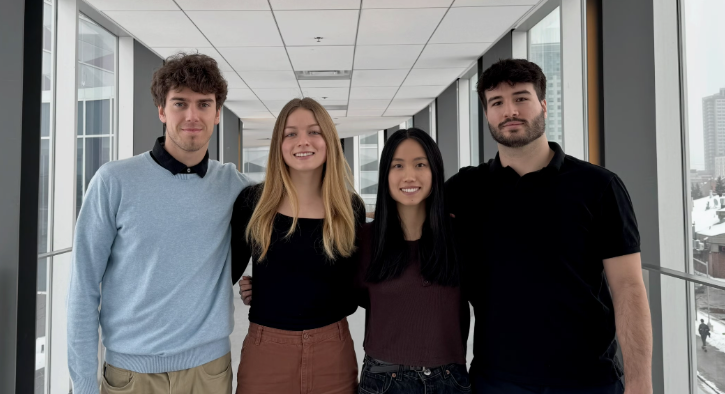
Victor Crisan, Marley O'Connell, Kyle Scenna, Lauren Toy
Post-stroke patients face elevated risks from unpredictable blood pressure fluctuations, which can lead to recurrent strokes. We are developing a comfortable, continuous, cuffless blood pressure monitor that uses an optical sensor to estimate blood pressure in real time. Our AI-driven solution empowers patients to understand and manage their blood pressure while providing clinicians with personalized, actionable data to reduce the risk of subsequent strokes.
WheelSafe (Capstone 2025)
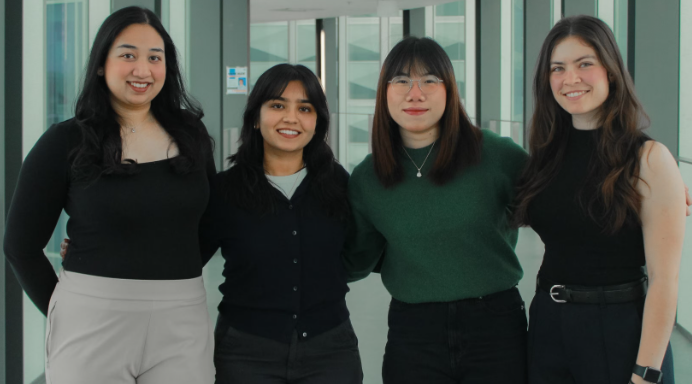
Khanh Le, Rayeeda Afrida Prerona, Isha Sharma, Sofia Rodriguez Suarez
WheelSafe is a system designed to mitigate backward tipping in manual wheelchairs, lowering the risk of serious injuries such as head trauma and spinal cord damage. It uses Inertial Measurement Unit (IMU) sensors to detect backward falls in real time and subsequently triggers a solenoid-based mechanism to stabilize the wheelchair. This design ensures quick response time, energy efficiency, and minimal interference with regular wheelchair maneuvers. WheelSafe enables users to navigate curbs and uneven terrain while maintaining their independence by striking a balance between safety, mobility and independence.
Student design teams
The Sedra Student Design Centre consists of over 20,000 square feet of space dedicated to design teams and student projects. There are more than two dozen design teams, all of which are student-led, and many of which represent Waterloo internationally.
Some examples include:
BIOMOD Team

The University of Waterloo BIOMOD team aims to solve real-world problems using biomolecular technology, from molecular robots to nanoscale therapeutics. Team members use software-aided design, wet-lab experiments, and engineering design to take great strides in health technology.
MedTechResolve

MedTechResolve aims to automate the process of diagnosis, treatment, and prognosis, both inside and outside of the emergency room (ER). The team participates in the John Hopkins Healthcare Design Competition annually.
Alternative Protein Project

The Waterloo Alternative Protein Project is the first chapter of the Good Food Institute’s Alt. Protein Project in Canada. The project aims to create a sustainable and secure food system through research, entrepreneurship, and innovation.
Biomedical Engineering alumni
Zoey Zhang
Zoey (class of 2024) was named in The Logic publication as a rising star for her work solving challenges and championing initiatives that advance inclusion in engineering.
Zoey’s time at Waterloo Engineering reflects her commitment to fostering a more inclusive engineering ecosystem. As the vice president of advocacy for the Canadian Federation of Engineering Students and co-chair of the 2023 Conference on Diversity in Engineering, she worked with faculty to launch the university’s first mental wellness survey and to improve diversity and inclusion in the university’s engineering school. She was awarded the Pearl Sullivan Emerging Global Leaders Award for her efforts to advance representation in engineering.
Zoey has been hired by Nvidia as a technical marketing engineer focused on advancing their machine learning tools. Zoey previously spent two co-op terms working with the Silicon Valley semiconductor giant, where she helped build the company’s first hands-on lab for medical imaging.


